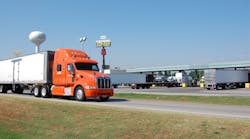Though capacity remains exceptionally tight, with drivers in short supply, industry experts remain unsure what kind of rate increases – if any – carriers may be able to achieve and keep going forward, as well as how “accessorial charges” for fuel, detention time, and others may be affected.
“The jury is still out on whether this is the year that truckload pricing really accelerates,” noted John Larkin, managing director and head of transportation capital markets research for Wall Street firm Stifel, Nicolaus & Co., explained in a recent conference call.
“We will not know for sure whether rates will move up as quickly as some carriers are suggesting until the weather has fully returned to normal and until spring and summer merchandise is forward positioned into place in the retailers supply chains,” he pointed out.
“While the driver shortage has never been worse, the economy still is not exactly robust,” Larkin added. “Higher local and state taxes, higher health care costs, stagnant job creation, and reduced levels of discretionary income – at least for many Americans – seems to be putting a cap on the rate of economic growth, and in turn the rate of freight growth, that can be expected for 2014 and into 2015.”
Ben Cubitt, senior VP-engineering and consulting for privately-held third party logistics (3PL) firm Transplace, added that his company is still encouraging shippers to bid at least part of their freight every year despite the more uncertain capacity environment.
“We encourage our shipper clients to bid very year simply because their networks change,” he explained. “They nominally end up with 30% t0 40% new lanes and carrier lanes remain very dynamic.”
That’s not to say, though, that such bid activity will help keep freight rates down, Cubitt stressed.
“Five years ago, most carriers showed the ‘white flag’ when it came to rates,” he noted. “Now though we’re seeing more competitive rates and I think some shippers are open to discussing rate increase. But they [the transportation managers] can’t go back to their companies and say they have to spend $1.5 million to $3 million more to move their freight. So it’s a contingent discussion in that shippers still remain under pressure to take out freight cost.”
That being said, Cubitt noted shippers are in his words “forgoing” cost reduction efforts in order to hold on to “core” TL companies in specific lanes.
“In 2008-2009, we saw shippers taking freight savings of 15% to 20%,” he explained. “In 2013, though, they took 8% to 12% savings – which net out to between 2% and 6% – and were not bidding their freight as regularly. They were also taking less savings in relation to their ‘incumbent’ carriers in order to align more freight with them.”
Yet other data shows that trucking capacity may be tighter than many think, leading to higher TL rates. Research firm FTR Transportation Intelligence, for one, said its Trucking Conditions Index (TCI) reading of 7.54 for February, while down slightly from the previous month, continues to reflect good news for trucking fleets as well as a warning to shippers seeking carriers to move their goods.
“The severe weather likely had a bigger impact and is not getting picked up in the data. When you adjust for weather, the TCI reading would be pushed above a reading of 10, certainly making this the tightest truck market on record,” noted Jonathan Starks, FTR’s director of transportation analysis, in a statement.
He added that FTR expects its TCI metric to remain in this range throughout 2014, impacted by truck freight demand accompanied by regulatory drag hindering available capacity.
“The most recent weekly spot market data shows that the spring thaw has come to truck demand with spot market capacity up and load activity down slightly – a plateau versus the last couple of months when both demand and pricing spiked while capacity was severely constrained,” Starks pointed out.
“Both carriers and shippers have to be on the lookout for a potential tipping point when freight demand is able to keep the current high level of truck use well into the summer months. Such an environment would necessitate shippers bidding up rates to maintain secure capacity during the fall shipping season,” he noted.
“FTR continues to evaluate the freight environment and currently sees enough moderation in truck demand to get through the year without a crisis – but it would only take a relatively modest and short uptick in the industrial sector for capacity to tighten significantly further,” Starks said. “We advise everyone to stay tuned to the manufacturing data to see if the thaw continues.”
“Accessorial charges” are also becoming a more important piece of the rate discussion as well, Cubitt added, noting that fuel surcharges remain the most common accessorial charge, with 93% of 175 shippers participating in an annual Transplace survey compensating carriers for fuel costs above a baseline price.
He pointed out that detention time also remains a frequent charge, with 74% of those shippers saying the compensate carriers for the detention of a power unit beyond a prescribed free detention period, and 72% compensating carriers for making multiple stops.
Such charges are also factoring in more heavily on the bottom line of carriers as well, Cubitt stressed. “Ten years ago TL rates averaged $1.50 to $1.53 a mile, with fuel surcharges making up 15 to 20 cents of that or 10%,” he explained. “Now, TL rates average between $1.55 and $1.60 per mile but fuel surcharges make up to 40 to 52 cents of that or 30% to 35% of the total cost.”
Still, Cubbitt said that so far this year, of the 22 TL bids Transplace has conducted for its clients, it’s been able to save 2% to 3% in freight costs relative to the prior twelve month period, though much of those savings come from matching freight lanes with carriers best suited to efficiently haul freight in them.
Yet that remains a clear example that sizable rate increases have certainly not been the norm so far, stressed Stifel’s Larkin.
“Carriers will have to ‘prove’ that capacity is approaching ‘sold out’ status before customers will be willing to offer anything more than just modest increases – i.e., low single digit year-over-year increases,” he said.
“Carriers are increasingly willing to collaborate with shippers to trade equipment productivity and humane driver treatment in exchange for flat rates or rates rising just modestly,” Larkin added. “Carriers are most interested in shippers offering compensatory fuel surcharges, rates that are in line with or above the market rates, reasonable payment terms, potential for volume growth, and a positive credit rating.”
He and Transplace’s Cubitt both noted that carriers also look for shippers providing driver friendly facilities, opportunities to enhance driver productivity and equipment utilization, and additional opportunities to sell their other services such as dedicated contract carriage, truck brokerage, intermodal offerings, etc.
“Carriers still haven’t done the best job relating their needs,” Cubitt added. “Shippers and 3PLs are very data-based and data-driven, so carriers need to have more ‘fact-based’ discussions about the need for rates and accessorial charges. They need to ‘arm’ shippers with accommodating data to support their rate requests.”



